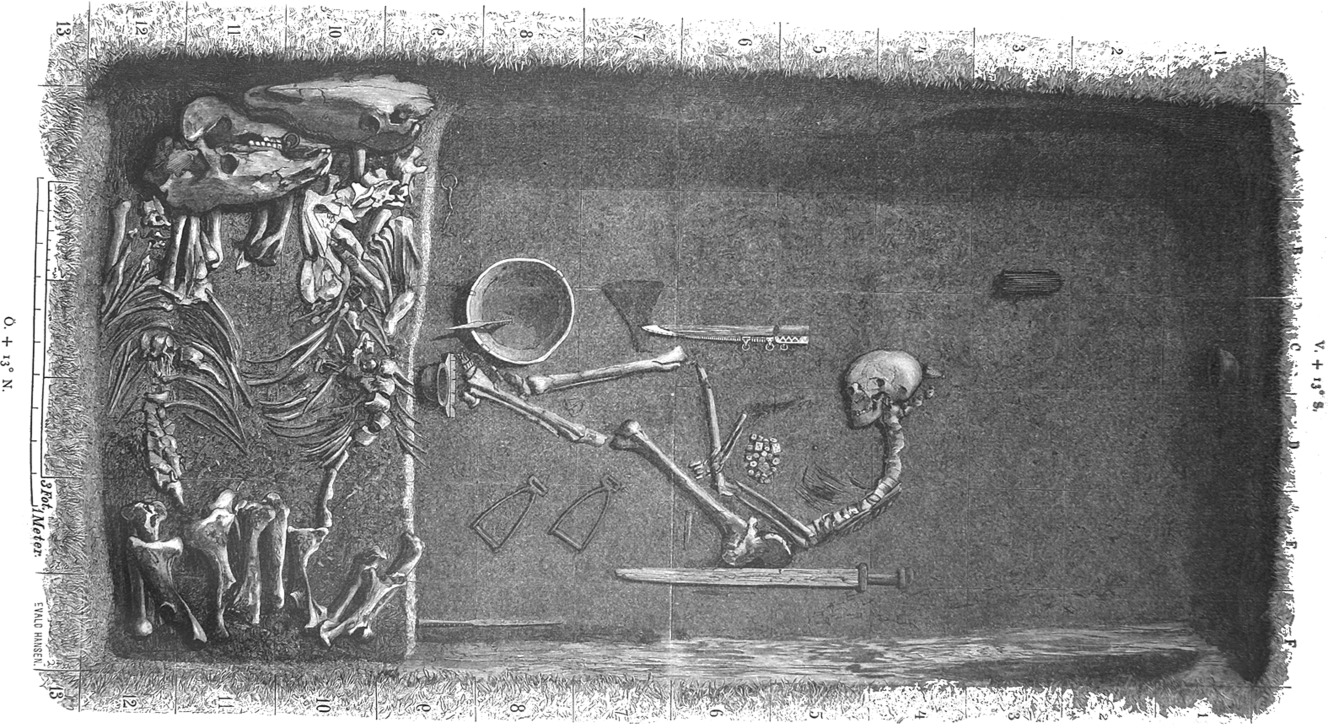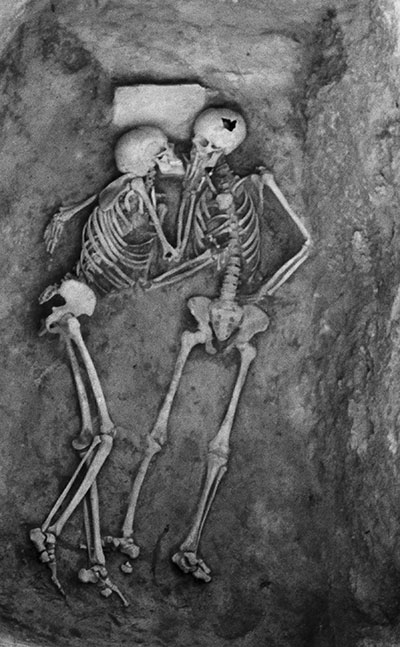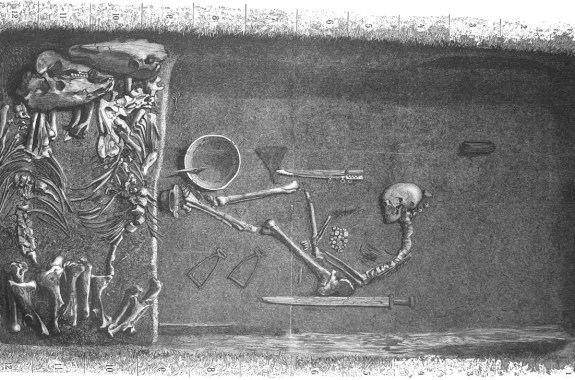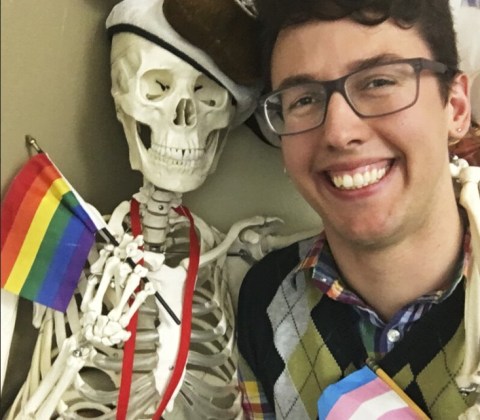Grade Level
9-12
minutes
60-90 minutes
subject
Life Science
stem practices
Analyzing and Interpreting Data
Activity Type:
archaeology, anthropology, ancient cultures
Skeletal remains can tell us a lot about the past. Evidence from human remains found around the world contributes to our understanding of what it was like to live in ancient cultures. When evaluating human remains, questions regarding an individual’s sex, gender, and sexuality often arise as a part of understanding their role within their culture. In this lesson, you will explore case studies of human remains that have challenged scientists’ ideas about how gender and sex operated in ancient times to help us better understand how gender, sex, and sexuality change our bodies and our stories in the present day.
This resource was created as part of the Science Friday Educator Collaborative.
Solving A Skeleton Mystery
Skeletal remains can provide a lot of information about how an ancient person lived, especially when they are in the context of a larger archaeological site. Take a look at the detailed drawing below, which shows a grave excavated from the Viking town of Birka, Sweden. What do you notice about the remains found there? Who do you think this person was based on the information shown here?

You might have noticed more than one skeleton in the grave, although one skeleton looks human, while the other skeletons have longer skulls. You also might have noticed that there are other objects in the grave, one of which looks like a sword.
The grave you examined above was located in a prominent area of the Viking city beneath a large stone connected to a military structure. This skeleton was found with two horses, several weapons, and a strategy game popular among warriors. Do you think the grave’s location or objects can give us any clues about their identity?
When the skeleton was originally uncovered in the 1870s, archaeologists believed this tomb belonged to a “battle-hardened man.” While most archaeologists still agree that this individual was a warrior, genetic evidence in 2017 suggested that this individual was not male at all. Genetic analysis showed that this person had XX, or female, sex chromosomes.
Information like the chromosomal results from this skeleton in Sweden can help shine light on the bias scientists can have when evaluating limited evidence. Viking stories included female warriors, so why did the original archaeologists who uncovered this grave assume that the individual was male? What other information tied into modern ideas about femininity and masculinity, sexuality, and gender roles have obscured our ability to understand the diversity of sex, gender, and sexuality in the ancient world? Many questions have arisen since this discovery, but as we will see, interpreting the remains of ancient people needs to be done with care, especially when we explore the past with a modern perspective.
No Bones About It: Neolithic Women Were Very, Very Strong
What Does The Evidence Tell Us About A Skeleton’s Sex and Gender?
In the context of this lesson, we are specifically interested in exploring clues connected to an individual’s sex, gender, and sexuality based on their skeletal remains and other clues from archaeological sites.
- Sex describes the physical characteristics of a person’s body, including sex-related organs (like gonads and genitalia), sex-related hormones, and how those hormones change the body and its functions. Words we use for sex categories include “male,” “female,” and “intersex.”
- Gender describes a person’s role within a society and can include being a woman, a man, and/or nonbinary gender. Gender roles relate to how a person contributed to their larger society, as the warrior remains described at the beginning of the lesson.
- Sexuality relates to how a person connects intimately to other people, if at all. When we use terms like “gay” and “straight,” we are often describing a sexual orientation, which is one part of sexuality. How sexuality is viewed is highly specific to a given cultural context and time period, and most clues we get about a person’s sexuality are not conclusive.
Take a moment to test your understanding of these attributes. Using the provided materials, sort the scenario presented on each card into the category you think they belong in: gender, sex, or sexuality. If it is unclear or you are not sure, use that category instead. Compare your assumptions with those of others in your class. Did you classify the scenarios in the same way?
Skeletons and burial sites provide a wide range of information about an ancient person’s sex, gender, and sexuality. Outlined below are just a few types of clues that can provide us with this information.
Sex Chromosomes
Sex chromosomes are specific parts of our genetic code that are one fundamental part of our sex. These chromosomes contain genes that change how fetal tissue develops into specific types of gonadal structures, affect hormone levels while in utero, and contribute to sex hormone levels during and after puberty. These chromosomes also contain genes that are not sex-related, like the genes for color vision and immune-related proteins.
| Sex chromosomes | XX | XY | XO | XXX | XXY |
| Frequency in live births | 48% | 51% | 1 in 3,000 | 1 in 1,000 | 1 in 1,000 |
| Common gonadal development | Ovaries, uterus, vagina | Testes, penis, scrotum | Ovaries, uterus, vagina | Ovaries, uterus, vagina | Testes, penis, scrotum |
| Other | Some XX individuals will exhibit different genital structures, which is related to hormone production or interaction while in utero. | Some XY individuals have no SRY gene or do not have a receptor for androgens like testosterone, leading to the development of internal gonads and a vulva. | Having only one copy of the X chromosome can have major effects, or they may not be observed directly until a person tries to create genetic children. | Having three X chromosomes usually has no observable symptoms, so it is possible this trait is more common than we think! | Having XXY chromosomes can have some observable symptoms, or this trait may not be observed until a person tries to create genetic children. |
Because sex chromosomes are a part of a person when they are born, they are considered a primary sex characteristic. The chromosome combinations above are just some of the possible sex chromosomes that a person might have in their cells, and sex chromosomes operate differently in different species. Here is a more complex matrix of sex characteristics to explore if you would like to see how chromosomes can interact with other sex characteristics to develop into the wide diversity of known human sex traits. This includes examples where sex chromosomes do not result in the developmental traits listed above due to other kinds of variation.
Archaeologists can test intact cellular tissue to detect the presence of specific sex chromosomes. The older the specimen, the harder it is to test for this trait.

Bone Structure And Density
Bone development is shaped throughout a person’s life by both hormonal influence and external environmental factors like diet and physical activity. Anthropologists use specific characteristics of bone to determine if a person had a system dominated by estrogen (typically XX) or testosterone (typically XY). Bone density can also show how much and what types of physical activity a person engaged in, since high-impact activity changes how bones grow and develop.
Bone development is one example of a secondary sex characteristic—something that is sex-related as a result of hormonal influence during or after puberty. If a person had not begun producing sex hormones yet because they had not started puberty, this makes identifying the sex of an individual using their bones less accurate. Others may have less common combinations of characteristics, which includes those with intersex traits.
Scientific bias also plays a role in determining the sex of skeletons. In 1972, a researcher named Kenneth Weiss found that a disproportionate number of skeletons analyzed by archaeologists had been sexed as male. An analysis of 43 skeleton collections found that scientists had sexed skeletons as male more often in ambiguous situations, leading to more male skeletons than would be expected in a random sample.
Clothing, Burial Objects, And Orientation Of Burial Site
One clue in understanding a person’s role in their culture is the objects and clothing they were buried with. A king or queen might be buried with valuable objects they had in life; a warrior might be buried with their weapons. Anthropologists observe patterns in the culture they are studying to determine what was typical for people of a particular gender. These patterns allow them to draw conclusions about future burial sites they uncover.
Sometimes individuals are buried together, which may suggest they had a relationship. The orientation of their bodies, location of burial objects, and even the location of the site itself can provide clues about who each person was and how they might be related. These clues vary between cultures and across time periods.
Podcast: Applying Your Learning
Listen to this podcast by Science Friday: “No Bones About It: Prehistoric Women Were Very, Very Strong” (transcript). While you are listening, identify how the anthropologists described in the article identified characteristics about the prehistoric people mentioned in the podcast. Record your ideas on the attached worksheet.
Case Studies: What Do These Graves Tell Us About Those Who Lived There?
Let’s learn more about how traits like gender, sex, and sexuality can be interpreted by scientists. Read or listen to one of the stories about human remains in Hasanlu (Iran), Pompeii (Italy), Georgia (United States), or Prague (Czech Republic) in the case studies. Record your ideas on this worksheet to organize your thoughts before sharing your findings with the class. As you read, reflect on our driving question: What stories do bones tell, and how do we tell those stories to others in an accurate and respectful way?
- Lovers, Friends, Or Strangers? New Thoughts On A Museum Icon
- Is That Skeleton Gay? The Problem With Projecting Modern Ideas Onto The Past
- Revolutionary War Hero’s Skeleton Suggests He Was Intersex
- “Gay Caveman” Story Overblown, Archaelogists Say
After becoming an expert on your case, share your findings with other students in your classroom. While others present, record the main ideas they share on the graphic organizer on your worksheet. Then answer the reflection questions before a final class discussion.
Wrap-Up: What Does This Mean For The Future?
Now that you’ve learned more about these case studies, what have you learned about how to tell the stories of ancient people in a respectful and accurate way? Discuss your ideas with the class. Can you agree on a common set of guidelines? If so, what are those guiding principles? If not, what guidelines are the trickiest to agree on? Try to be specific when identifying how to talk about sex, gender, and sexuality.
Next Generation Science Standards
This resource works toward the following performance expectations:
- HS-LS3-3: Inheritance and Variation of Traits – Apply concepts of statistics and probability to explain the variation and distribution of expressed traits in a population.
Credits:
Lesson by Lewis Steller
Draft Development by Xochitl Garcia and Sandy Roberts
Copyediting by Crystal Erickson and Ariel Zych
Reviews by Pamela Geller
Digital Production by Sandy Roberts
Educator's Toolbox
Meet the Writer
About Lewis Steller
Lewis Steller is a queer and transgender science educator interested in ambitious and equitable science education for all students.


